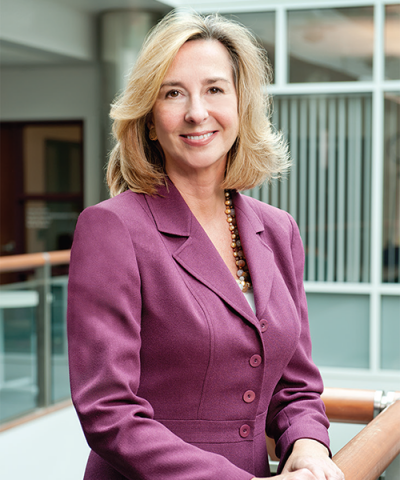
Photo: Webb Chappell
Babson President Kerry Healey
The idea for the program came during my term as lieutenant governor when I had the opportunity to learn firsthand about the transformational scientific, medical, and technological research and inspiring work being done in our higher education institutions across Massachusetts. Shining City also celebrated Boston as a unique ecosystem that supports bold, new ideas while nurturing the dynamic leaders and entrepreneurs in our own backyard who are making a positive global impact.
Understanding the critical connection among innovation, entrepreneurship, and solving the world’s most challenging problems led me directly to Babson. Babson entrepreneurs are seeking society-changing solutions in every field, and I am seeing more and more attention being devoted by our students and alumni to creating and innovating across every aspect of the health-care industry.
The promise of discovering new treatments to help people live longer, more productive, and healthier lives is certainly a priority for all of us. This issue of Babson Magazine features alumni who are taking action in the biotech industry as company founders, leaders, researchers, and consultants seeking smart solutions to vexing health-care challenges (“Imagining the Unimaginable”). These alumni also represent a growing trend across our MBA programs. Careers in health care and the life sciences are trending upward and now represent the second most popular landing spot among our graduate students, with 16 percent choosing employment in these fields.
With annual health-care and related expenses in the United States estimated to reach $4 trillion in 2015 according to a Deloitte study, opportunity exists for Entrepreneurs of All Kinds to positively influence the future. Myriad challenges not only include bringing headlinemaking new treatments to market, but also finding new efficiencies throughout the industry to slow spiraling costs. Those costs threaten access to and availability of the services that society has grown accustomed to but may not be able to afford long term.
Health care is a massive industry that is ripe for disruption, while also holding incredible promise and hope for the future. We can take pride in knowing that Babson entrepreneurs will be at the forefront in finding new and better ways to deliver a higher quality of life for people everywhere.

Kerry Healey
]]>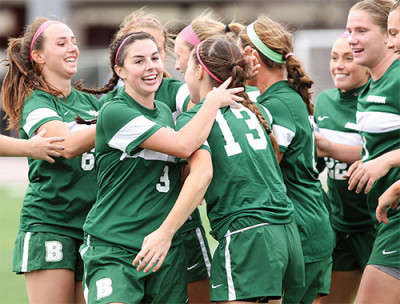
Photo: Jon Endow P’17
Colleen Beggan ’18 (center, left) celebrates a goal by teammate Emma Dineen ’19 (number 13) during a NEWMAC Tournament semifinal game, which the Beavers won.
A history-making moment unfolded for the women’s soccer team last semester. For the first time in 35 seasons, its name was called during the NCAA Tournament selection show on November 9. “When that reality check hit and we saw Babson appear on the screen, I felt so proud of our team and everything we had accomplished,” says Colleen Beggan ’18, one of the team’s defensive leaders. “It was an honor. Truly amazing.”
After hearing their name called, the Beavers learned they would face the defending national champions, Lynchburg College, in the first round. Babson traveled to Rowan University in Glassboro, New Jersey, to compete and battled mightily with the Hornets before falling 1-0.
The team posted a record of 14-4-5 overall and 5-1-4 in the NEWMAC, racking up its most wins since 1993 while posting its third highest victory total in program annals. The Beavers also set a school record with 14 shutouts and advanced to the conference tournament championship game for the first time since 2011.
Sixth-year head coach Nellie Pineault, MBA’03, says preparation played a key role in the team’s success. “We were very focused on the little things, on the process, doing things in practice that made a difference in the game,” she says. “We continued to develop and grow as a program and played in the NCAAs for what ultimately has been our goal not just since August but for years.”
Beggan says, “We felt like everything came together— from the work we did in the preseason, at practice, and during lifts—for the moment when we stepped foot on that field in New Jersey. We played for each other and for our seniors. That experience was special, and knowing we were the first to do it made it even more memorable.”
Although the final outcome wasn’t what the team had envisioned, members have plenty of positives to take away from the historic season, and the 20 returning Beavers look forward to playing in 2016.
“One area we’ve really emphasized to the team is pride,” says Pineault. “Pride in the program, pride in representing the school, wearing green and white, and representing the alums who have all played before them.”—Scott Dietz, associate director of athletics
]]>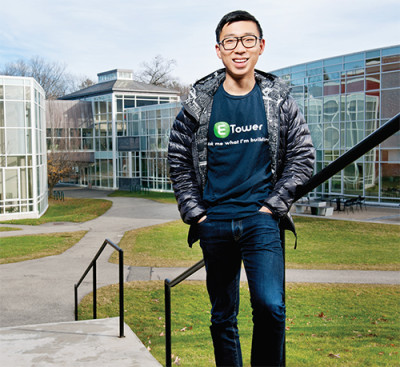
Photo: Webb Chappell
Derek Tu ’18, president of E-Tower
With 22 current members, the tower’s track record speaks to the power of that atmosphere. About 90 students have lived in E-Tower, located in Van Winkle Hall, since its founding in 2001, and they’ve launched an impressive list of companies, including IdeaPaint, Virool, NatureBox, ThinkLite, and CompStak.
But while these successes are a large part of the community’s story, E-Tower also is a story of missteps and redemption. Several years back, the tower fell on hard times of its own making as it strained relations with campus administration. There were unfortunate incidents, says Tu, including large, out-of-control parties that caught the attention of campus police, as well as a culture that turned competitive and stressful, with members feeling pressured to produce results on businesses. In 2012, the College took away the group’s on-campus housing.
E-Tower returned to campus in 2013, and since then has done the hard work of repairing its relationship with school officials, rebuilding its reputation, and restoring a more supportive environment. “We lost our identity,” Tu says. “We had to do some soul-searching.” Today, the tower is again a thriving community, a collaborative place where students leave the door to their rooms open in case someone should pop by with a question.
Every Wednesday evening, about 80 students pack the tower’s general member meetings, which are open to any student who would like to attend. Attendees give feedback on business ideas, listen to speakers, and get to know each other by breaking into groups and talking about real, personal issues: aspirations, fears, what drives them.
From these general meetings, the tower recruits students to live in its community. “We are going after people who are hustlers,” Tu says. “That’s anyone who’s interested in entrepreneurship. That’s leaders. That’s people who desire to question the status quo.” Starting a business is not a requirement to join the tower, though 11 ventures currently are run out of the space.
This academic year has been particularly productive for the group. Among other accomplishments, it raised $34,000 to refurbish its space and held an entrepreneurial conference attended by many alumni. “What an incredible group,” says Len Green, an adjunct lecturer of entrepreneurship and the group’s adviser, who is proud of how the group overcame its past circumstances to foster a renewed entrepreneurial spirit and to raise funds to improve its space. “E-Tower,” he says, “exemplifies what Babson students are all about.”—John Crawford
]]>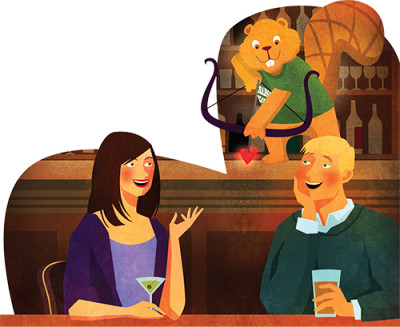
Illustration: Dermot Flynn
Tina Armentano and Sam Bowlby, both MBA’11
Tina and I met at Babson, although we were not in the same MBA section. We met over multiple Natty Light beers at Roger’s Pub. While I was attracted from day one, Tina had a pesky boyfriend in New York City. I was attracted to Tina’s very “profesh” blazers and 7-inch-high heels. I think Tina was attracted to my vintage L.L. Bean attire and unrelenting wit. Eventually, she succumbed to my dance moves at the old An Tua Nua, a favorite Boston bar of our class (sadly, now closed), and agreed to a date. Classy guy that I am, I conducted our first date at the Coolidge Corner Clubhouse sports bar. I’m sure Tina was impressed by the 12 packs of complimentary garlic breadsticks that I ate.
I knew Tina was the one when she wasn’t immediately repelled by any of my sophomoric antics. Tina says she knew I was the one when I started closing the bathroom door. I proposed to Tina at her grandfather’s country home in New York. The night before, I put the ring, a 5-pound weight, and a chemical light in a plastic bag and then threw it into a pond on the property. The next day, Tina joined me for a walk and noticed the glowing light in the pond. Feigning ignorance, I bravely offered to jump into the pond (in March!) to retrieve the goods and returned with the ring. We were married in September 2013.—Sam
Curran Leahy and Dennis Lonigro, both ’00
We had mutual friends, spent four years “together” in the same graduating class, and our individual pictures appeared on the same page of the yearbook. Yet it took a chance meeting online 14 years later for Curran and me to make each other’s acquaintance. Despite an immediate connection, I was a bit jaded with the dating scene. Curran literally had to drag me out on our first date at The Cottage, a restaurant down the street from Babson. I’ll never forget the feeling of knowing that this was something special, and I nearly blew it. It has been a blast learning about our shared connections and experiences from our Babson years.
On this past Halloween, after a year of fun and adventures (including our 15th class reunion), we got engaged at the Roger Williams Zoo Pumpkin Spectacular, which features hundreds of professionally carved pumpkins. To Curran’s complete surprise, the last pumpkin on the trail was carved with “Will you marry me, Curran?” She said yes, and Babson friends were among the first to know and to share happy congratulations.
We didn’t meet at Babson, but our shared affection for Babson certainly contributed to our affection for one another. We’re planning our wedding and are so excited to continue our fun, love-filled life together.—Dennis
Rashida Malcolm-Bradley and Chris Bradley, both ’08
Both originally from New York City, Chris and I met at the Babson Multicultural Overnight Experience for prospective high school seniors in spring 2004. I had already accepted my offer to attend Babson via early decision as a Posse Foundation scholar. He was still contemplating whether to attend but already had earned a scholarship. Years later when we tell the story to friends, I credit our great interactions over the weekend (and of course my winning personality, LOL) as helping to finalize his decision.
When we started Babson that fall, we both were in relationships from home. But we quickly bonded over long study breaks and our plans for the future. We were basically inseparable on campus and even spent most of our Thanksgiving break together in New York. I remember being stressed leading up to finals week when he asked me to be his girlfriend on the walk from Trim to Forest. Can you imagine having your anniversary during finals week for the next three years!
We have been together ever since. In spring 2012, Chris proposed. If you know anything about Chris, he loves a good steak. So it wasn’t out of the ordinary for him to ask me to join him for dinner at Ruth’s Chris Steak House. After a romantic and private proposal, 30 of our closest friends and family joined us on our blissful evening. In August 2013, we were married and currently live in Geneva after moving for a career opportunity. We’ve had an amazing first few years of marriage living and traveling around Europe.—Rashida
Diane (Belesca) ’85 and Jim Gardner ’84
Jim and I met in Fort Lauderdale on spring break when I was a sophomore and he was a junior. I traveled with a group of girlfriends, and Jim was with a bunch of Theta Chi friends. Although we hadn’t gone on break together, we recognized enough people in both groups to know we were all from Babson. I was attracted to Jim right away. If you know anything about crazy spring breaks, Jim stood out because he was fun and a real gentleman. One night we spotted each other at a bar off the beach. Jim was counting his pennies but offered to buy me a drink. I ordered something fancy and too expensive.
Back on campus, we continued dating. Parents Weekend was in late April then, and my parents came. Jim met them at Casino Night in his seersucker suit and white bucks just a month after we had started dating. They liked him immediately. During my senior year, Jim came to Babson, often visiting me while I managed the then-Beaver Brau Pub or for one of my field hockey games.
He proposed to me in November 1985, and we got married in September 1986. Many Babson friends celebrated with us on Chebeague Island in Maine. And, 30 years and three children later, we’re still in love, still really good friends, and now we work together as well.—Diane
]]>
Illustration: James Steinberg/theispot.com
As a result, Common Threads decided to ask clients to help pay for its nutrition programs. “Most of the schools we work with now, which is about several hundred across the country, receive our services for free,” says Holly Raymond, CFO of the nonprofit. “We need to make them see the value of the program and agree to pay for a part or all of it.”
But how? For help with its marketing and financial strategies, Common Threads turned to Babson’s Management Consulting Field Experience (MCFE) program, which partners students with organizations seeking business advice. The challenge appealed to five undergraduates who all knew each other from having held executive positions in a professional fraternity for business majors: Christina Gee and Anamaria Najera, both ’17, signed up first and then told Gabrielle Mosher, Nicole Sun, and Megan Tsai, all ’16, about the project. Alfredo Keri, MBA’16, came on board as team leader to guide the undergraduates.
“We realize how important the group dynamic is to the success of a project,” says Tsai of her team. “You’re submitting your work to a real company, with professional people who will take you and your recommendations seriously. This brings real pressure and pushes you to do something that you’re going to be proud of. This is not just a grade.”
After talking with Common Threads to understand its mission and goals, the team gathered mid-semester to present their preliminary findings via a video conference. Social media marketing played a prominent role in the team’s recommendations to help constituents—schools, parents, funders, and culinary experts—understand the nonprofit’s value. Suggestions included enchancing search engine optimization of the nonprofit’s Facebook page with the help of volunteers, asking them to tag photos, for example. Twitter was discussed as useful for broadcasting real-time, quick bursts of information, which followers could be encouraged to retweet. The team also suggested hosting a weekly event on Instagram, which they named “Savor Sunday,” and using it to upload new culinary information for communities as a way to keep users involved.
The team created a pricing model to help the organization determine how much a school could pay. They also proposed using the price generated by the model as a starting point for discussions— not a hard-and-fast number—to encourage schools to participate.
Other suggestions included asking parents to help sustain the program at their schools and engaging them as volunteers who can help teachers. Also, the team recommended reaching out to local culinary experts, especially restaurant chefs, to form relationships in which the program and experts promote each other.
“The project has been a huge learning experience,” says Tsai. “The MCFE program is not for someone who isn’t internally motivated. We have all learned how to keep the end goal in sight and define the steps necessary to get there. The experience has taught me how to handle my schedule, manage stress, and stay on track. It’s been great working together for a common goal.”
Common Threads enjoyed working with the team as well, says Raymond. “They’re so positive and bring such a different outlook,” she says. “They have fresh, new ideas. Their energy, intelligence—it’s been amazing.”—Sharman Andersen
]]>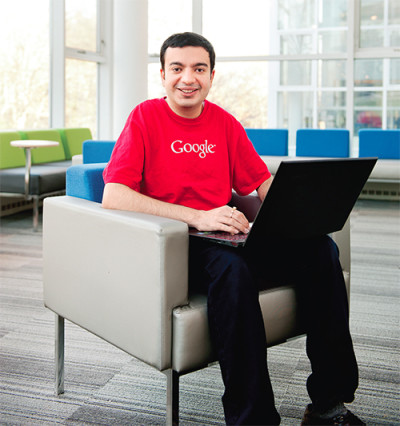
Photo: Webb Chappell
Sanmay Ved, MBA’16
The implausible happened when Ved was indulging in what tech folks call dogfooding, or the testing of new products. It’s a hobby of his. “I love dogfooding,” says Ved, who originally hails from Mandvi, a small city in western India. “I love trying new products out.” The night owl was staying up late, as he often does, and checking out Google Domains, a new site that allows users to register domain names. For 5 1/2 years, Ved worked at Google in the Indian city of Hyderabad, and he remains a fan of the company, keeping tabs on its latest developments. “I love Google,” he says. “It’s a nice place to work. They take good care of you.”
To test out Google Domains, Ved decided to enter a domain name. “What’s the first domain that comes to mind?” he asks. “Google.com.” So on a lark he typed it in, and, surprisingly, it was available for purchase. Obviously this was a mistake, he thought, one that would surely correct itself. Just to see what would happen, Ved next added the domain to his shopping cart. He assumed Google Domains wouldn’t allow that to happen, but it did.
Finally, Ved proceeded to checkout. The website certainly would stop this now, he mused. Of course it wouldn’t let the purchase continue. But that’s exactly what happened. Ved bought Google.com, and he received notification that his credit card had been charged. “Did I do what I think I just did?” he wondered. He then went to a separate Google site, Google Search Console, which allows domain owners to check the status and visibility of their websites, and it showed that he was indeed the owner and gave him access to the domain.
Ved didn’t have much time to dream up what he was going to do with Google.com. After about a minute, he received an order cancellation from Google. Just like that, his unexpected ride at the top of Google.com was over. Ved alerted Google to what had happened, and they offered him a reward for what he had discovered. He turned them down, but then Google insisted. “It was never about the money,” Ved says. “I don’t want any money.” So Ved asked that the reward be donated to a favorite charity of his, The Art of Living Foundation in India, which provides free education to poor Indian children, and Google not only agreed but also doubled the amount. (Ved declined to discuss how much.)
Ved’s unusual one-minute purchase also brought him notoriety. In the past, he had found other glitches on Google sites but never discussed them. This time he decided to share his story with his LinkedIn connections. But then they started sharing his post, and word spread until Business Insider contacted him for an interview, which he granted. Then the story really took off as dozens of other media outlets picked it up. Students stopped him on campus, and he heard from lawyers, who claimed he had a case against Google, and from many additional journalists seeking interviews. “I was getting requests left and right,” he says. “I lost count of how many.” Not interested in any further publicity, Ved only granted two more interviews: to his hometown newspaper and Babson Magazine.
After a few weeks, the attention finally faded away, leaving Ved amused by everything that had happened after one late night on his computer. “I doubt something like this will happen to me again,” he says.—John Crawford
]]>“Chocolate reimagined” is the store’s motto, says Shah, who makes each tasty morsel a piece of art. “Chocolate is a combination of everything I love doing,” he says. Grow-ing up, he enjoyed cooking, painting, sculpting—anything that involved creative arts. “My chocolates are visually colorful and textural. They’re also a combination of things I’ve experienced, including flavors from my Indian culture and different cuisines I’ve tried.”
Much of Shah’s inspiration for Xocolatti came from his mother, a talented baker who helped him start the business. Shah says his whole family is full of foodies. “When I make a flavor, everyone is criticizing it,” he says, “but that helps us perfect the flavor.”
For Valentine’s Day, Shah pulls together a special collection of truffles, which includes such flavors as passion fruit (his personal favorite), rose cardamom, and champagne brut. “They’re luxurious and rich,” he says.
Shah, who always wanted to “do his own thing,” credits his education for helping him start Xocolatti. “Babson gives you a foundation on how to start and run a company,” he says, “and then everything is a learning process. You make mistakes, and you learn from them. But once you know how to start a company, you can pursue whatever passion you want.”—Donna Coco
]]>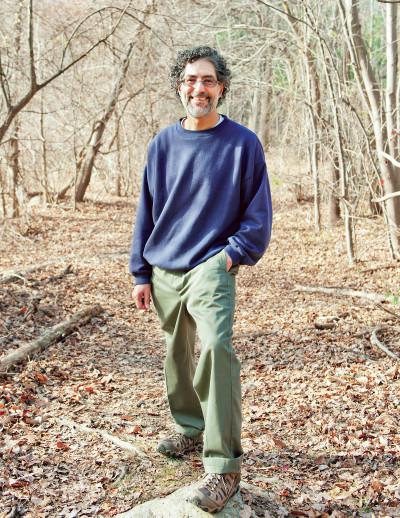
Photo: Webb Chappell
Craig Ehrlich loves to hike and goes to the mountains as often as he can. Each semester, he offers students the opportunity to join him on a hike, and a few always come. “It’s a nice way to spend a day,” he says.
As a bonus, Ehrlich discovered that he loves teaching. “This is fun,” he thought of his classes with the service members. For the first time in his life, he knew how he wanted to earn a living. Become a professor.
Ehrlich never liked being a lawyer. He studied psychology and linguistics as an undergrad at the University of Illinois, but upon graduating felt like he had no employable skills. People suggested he continue at the university and go to law school, presenting the idea as if he would have many career choices with such a degree. “Which, by the way, is nonsense,” he says. “It leads to the practice of law.”
Three of the most unhappy years of his life is how Ehrlich describes law school. As somewhat of a lost soul who was there because he wasn’t sure what else to do, he found that the super competitive law school environment didn’t suit him. But he persevered and even landed an internship that turned into a job at a boutique firm in Chicago specializing in an unusual and rare branch of law called chancery. There’s no jury, Ehrlich says. People go to court looking for the judge to order an act be performed, such as imposing an injunction or dissolving a partnership. “It was pure litigation,” he says. “Nonstop fighting it out in court in commercial and corporate disputes.”
Ehrlich describes the lawyers he worked with as brilliant. They also were remarkably aggressive. “I’m just not,” he says. Although he learned much and did his job well, he wanted out. “I hated every single minute of it,” Ehrlich says. “I used to go home with migraine headaches every night. What am I doing? I’m a hippie. I’m not a fighter. I spent enough of my youth getting beat up by the next-door neighbor’s kid. Did I really want to be in combat every day? No. But there I was.”
Searching for a better way to use his degree, Ehrlich moved with his wife to South Korea after visiting the country on their first wedding anniversary. An orphan from South Korea, she was brought to America as a teenager. The two had met in Chicago and married. “I thought I’d like to see where she came from,” says Ehrlich of why they took that initial trip. During the visit, he met another American lawyer working in Seoul who talked about four South Korean firms that handled most of the international business. To help with Western clients, those firms hired U.S. lawyers. Ehrlich sent his resume to all four and soon was on his way overseas.
Initially, the transition to a new culture was exciting and the job interesting, as Ehrlich worked on deals brokered with some of the top lawyers in the U.S. He worked with Fortune 500 companies, European and Japanese companies, and foreign embassies. The most exciting cases he can’t talk about due to confidentiality, but, he says, “The criminal stuff was fantastic.”
Eventually, though, the excitement of working overseas wore off and Ehrlich longed to return to the U.S. “After a while it just got monotonous,” he says. “I wanted to come back home to a place that seemed familiar.” With a daughter now to look after, he and his wife also wanted to raise their child in a more diverse culture.
Having discovered a passion for teaching through his work on the American base, Ehrlich set out to land a job as a professor of law, applying to colleges and universities all over the U.S. Babson responded, Ehrlich interviewed, and soon after he was offered the job. The year was 1996, and he has been teaching here ever since.
In addition to teaching “Business Law,” Ehrlich designed two other courses that he teaches, “Building Contracts for New Ventures” and “White Collar and Corporate Crime.” His courses help students understand some basic facts about how the world works, says Ehrlich, so people won’t be able to take advantage of them. In the contracts course, he asks, “Can you stand on your own two feet and not let people cheat you or force a bad deal down your throat?” His course on crime aims to help students avoid legal trouble. “We live in an increasingly criminalized legal environment,” he says. “There are more crimes on the books today than ever. It’s easier than ever to go to prison.” Ignorance of the law, he says, is not a legal defense.
Studying law also teaches students how to read and interpret difficult text, says Ehrlich. “Fewer people actually sit and read quietly and at length,” he says. “They’re good at skimming, if they do anything. So number one—can you read something that is dense, where every word counts?” Then can students translate their thoughts into clear prose. Honing these skills will serve them well, he believes.
Despite the seemingly weighty topics that Ehrlich addresses, he still says teaching is “absolutely fun.” He admires the inquisitiveness of the students. “They’ve got a million questions, and they’re really good questions,” he says. “I’ve been reading law now for about 40 years, and how come I never thought of that one? What a good question. Still happens that way.”
Even when Ehrlich’s day has not gone so well, the classroom lifts his spirits. “The students listen. They laugh at my jokes,” he says. “Seriously, what more could you want?”
]]>12. Seeing Peonies
I thought of you again today, Brother,
riding my bicycle slowly by a row of peonies,
perfumed and ragged in their low bowing
last blush: impossibly bushy scarlet flowers,
overcrowding their stems to the point of almost
falling into the long gold grass, but holding,
a delicate weight. I tell you, I glanced back
just in time to see the warm wind’s remnant
in their rippling, a quiver I might not have
seen that seemed to lift each head once
more into the early summer sun before
letting it settle down at last. I’m trying
to let go your hold, my Brother. Trying not
to keep seeing you in every shift, or opening
into shadow. To learn to bend low. Let go.
“Poetry for me is always about discovery,” says Mary Pinard, professor of English at Babson. Portal, her first book, is a collection of poems that attempts to make sense of the loss of her brother, who drowned in a tugboat accident. He died in an estuary in Grays Harbor, Washington, where the Army Corps of Engineers had been dredging for many years. “My first impulse was to mourn,” says Pinard, “but then I wanted to understand, to find answers.”
Pinard uses poetry as a means to tell stories, which she says are influenced by their settings, such as the estuary where her brother died. “I thought of the estuary and how it was formed by nature and re-formed by the Army Corps,” she says. In “Song Net for an Estuary,” Pinard explores the accident through 15 linked sonnets about her brother’s life, tugboats, and marine biology. “Each sonnet stands on its own, separate though connected,” she says.
Pinard wrote “Salvagings,” a poem in 13 parts, during a monthlong, summer writers residency. The 12th part, “Seeing Peonies,” addresses her brother, trying to make peace with his death. “Every day I would ride my bike along a rural road and see those peonies, how they were falling over, blowzy and fragrant,” says Pinard. “I began to think of connections. How the peonies bowed over, how their blossoms would fall down and let go. I realized I would like to let go of my grief. I was ready to move on.”
When creating a poem, Pinard normally works with parts of ideas. “When I don’t have uninterrupted time to write, I work a lot in my head,” she says. “In order not to lose contact with a poem in process, I think about it while I’m doing the dishes, while I’m at the market. So when I get back to my desk, I can add to it.”
Pinard encourages her students to experiment with poetry. “Poetry is not an elite art form,” she says. “It helps us understand who we are and our relationship to the world. We all have the capability to write poetry. We just need encouragement and guidance.”
]]>Where do your story ideas come from? There’s a fair amount of me and a fair amount of other people in the book. Some of the stuff that’s hardest to write is actually about people I’ve known. I became close with a couple of students when I taught at community college, and they were the kind of kids who should be looking at a future for themselves, but it’s western Pennsylvania, so instead they were focused on reproducing their parents’ postwar, working class lives, and those options aren’t there anymore. They just don’t exist. And so writing about those kids struggling and ultimately failing to work beyond that is tough.
Before becoming a teacher, you worked a bunch of jobs. Tell us about one. I got a job working for Leidy’s Pork Products. It’s every bit as glamorous and fun as it sounds. I had to get a pair of steel-toe rubber boots; they provided the white coat and apron. It was summer and I worked inside a refrigerator, so my nose was running all the time. It was awful. I did not end up a vegetarian, though. People always expect that and I’m like, no, I grew up a German boy in Pennsylvania. There’s no vegetarianism for me.
You taught Lady Gaga in a writing class for gifted teenagers. What was she like? She was a smart kid. She told stories about working with a choreographer and with a vocal coach, and she wanted to be the next Christina Aguilera or Britney Spears. She was very serious about studying the music business at 15, and she made it. She made it about as far as she could go, so I have nothing but admiration for that.
Any hobbies? Reading has always been a hobby. I like gardening. I’m a gamer. I feel like the escapist fictional worlds of video games have become part of my writing process. I write about these kids who break my heart when I think about the choices that they made and the directions their lives went in, and so I come back from the library or the cafe kind of weeping, and I escape into the Xbox and go solve imaginary problems for imaginary people.—John Crawford
]]>